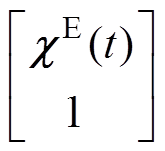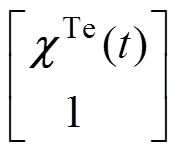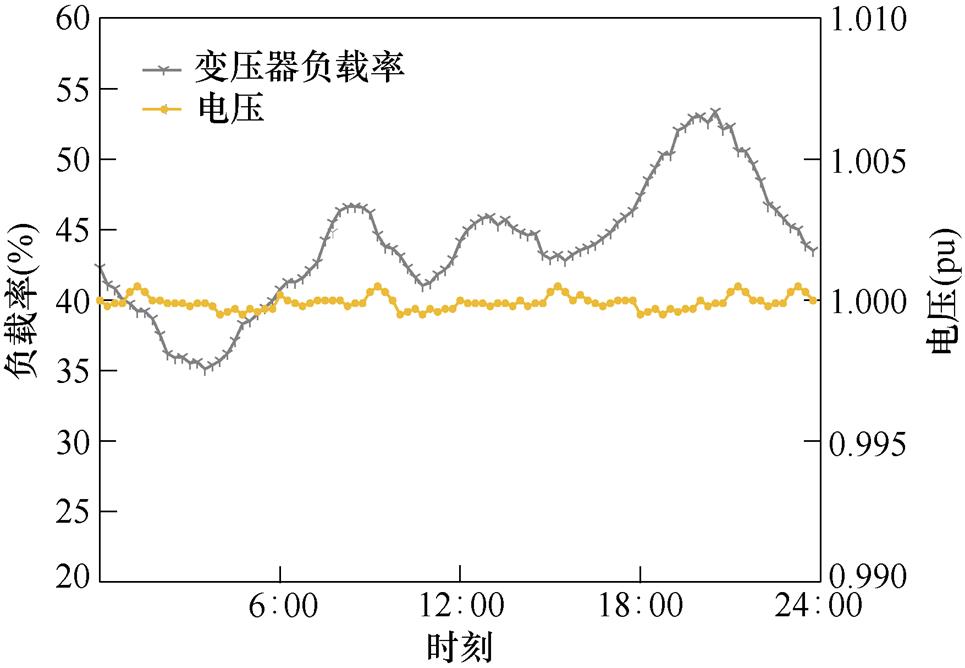 次应力造成的累积损伤
次应力造成的累积损伤 为
为摘要 针对目前缺乏依托在线物联感知数据的电力变压器绕组绝缘劣化评估方法的问题,该文考虑电、热、机械劣化因素对电力变压器绕组绝缘的损伤累积效应,提出基于物联感知数据和张量融合的电力变压器绕组绝缘劣化评估方法。首先,研究电、热、机械因素对绕组绝缘的累积损伤机理,依托电压、电流、温度、局部放电物联感知数据构建变压器绕组绝缘的电性能、热性能和机械性能劣化损伤指标;然后,构建三种劣化损伤指标的特征张量,基于张量融合对三种劣化损伤指标进行特征融合,提取劣化损伤指标间的高维劣化特征关联信息;最后,采用基于自组织映射网络(SOM)的最小量化误差方法构建绕组绝缘的综合劣化评估指标,实现对绕组绝缘劣化状态的评估。该文通过多种评价准则评价构建综合劣化指标,算例结果表明,所提方法能准确评估变压器绕组绝缘的真实劣化程度。
关键词:电力变压器 绕组绝缘 劣化评估 物联感知数据 张量融合
变压器的绝缘劣化程度是绕组、套管、油箱密封圈多部件的绝缘劣化程度共同决定的[1-3]。其中绕组绝缘长期处于交变电磁场、局部放电、热点温度、机械振动等因素构成的复杂运行环境中,相对于其他部件劣化行为更加明显[4-5]。文献[6]的调查结果显示,38%的变压器故障来自变压器绕组绝缘的劣化,在所有部件中故障占比最高,所以绕组绝缘劣化评估对变压器的安全稳定运行具有重要意义[7]。绕组绝缘劣化评估的目的是通过构建劣化指标评估绝缘劣化程度,进而预测绝缘劣化趋势和剩余寿命,为变压器检修计划的制定提供具体化的参考[8]。
传统的变压器绕组绝缘劣化评估方法多依托油中糠醛量[9]、甲醇量[10]和含水量[11]等数据表征绕组绝缘的劣化程度,这类数据随绝缘劣化的加深有明显的单调性趋势,能准确地反映绕组绝缘的劣化状态。但由于目前对这些数据难以实现连续的在线感知,只能在变压器检修时对绝缘油采样后离线分析获得,无法实时掌握绕组绝缘的劣化状态。
随着物联(Internet of Things, IoT)感知技术在电网中的普及,电压、电流、温度、局部放电幅值等变压器性能数据的在线感知成为可能[12]。在此背景下,部分学者开始研究变压器绝缘的在线故障诊断方法:Han Rui等提出基于电压电流关联挖掘的变压器绕组变形在线诊断方法[13]。Lei Cheng等依托温度、局部放电等数据,提出了基于径向基函数(Radial Basis Function, RBF)神经网络的变压器绝缘在线故障判别方法[14]。P. A. Venikar等研究了基于空载和轻载电流谐波的变压器绝缘在线故障诊断方法[15]。这些研究均具有较高的应用价值,但都侧重于研究绝缘在线故障诊断,而不是绝缘劣化评估,原因在于电压、电流、温度、局部放电幅值这些易于在线感知的变压器性能数据不会随绝缘的劣化表现出明显的单调性和趋势性特征,不能直接作为反映绕组绝缘劣化程度的指标。
为实现变压器绝缘劣化程度的在线评估,国内外学者从不同角度出发,构建依托物联感知数据的变压器绕组绝缘劣化指标:周凯等通过对局部放电信号高频采样,分析局部放电量偏斜度等高频特征与绝缘劣化的相关性[16]。Cheng Lefeng等以温度作为协变量构建了绝缘劣化的故障率指标[17]。李莹等从机理角度,依托电流数据研究了轴向应力对绕组绝缘劣化的影响[18]。这些研究对变压器绝缘劣化的在线评估起到了推动作用,但都只从单性能因素角度进行劣化评估,而变压器绕组绝缘劣化是电、热、机械多个具有高维相关性的因素共同作用的结果,仅考虑单性能劣化因素构建的模型难以全面真实地反映绕组绝缘的劣化行为。
也有学者尝试借助机理分析[19]、数值建模[20]、机器学习[21]方法构建多因素作用下的变压器绝缘劣化评估模型,但大多仍依托绝缘纸抗拉强度、聚合度、糠醛量等难以在线感知的数据构建,无法应用于绕组绝缘劣化的在线评估。
现有绕组绝缘劣化评估方法存在的问题:①由于糠醛量等能准确表征绕组绝缘劣化的数据难以在线感知,基于这类数据的评估方法无法应用于绕组绝缘劣化的在线评估;②基于电压、电流、温度、局部放电等物联感知数据的劣化评估方法大多只考虑单一劣化因素对绕组绝缘劣化的影响,难以全面真实地反映绕组绝缘的劣化程度。为此,本文提出了基于物联感知数据和张量融合的电力变压器绕组绝缘劣化评估方法,优势在于:①依托物联感知数据量化电、热、机械应力对绕组绝缘造成的累积损伤,构建的电、热、机械性能劣化损伤指标能准确刻画三种应力下的绕组绝缘劣化趋势;②基于张量融合方法对三种劣化损伤指标进行特征融合,在保留每种劣化损伤指标特征的同时,充分提取劣化损伤指标间的高维劣化特征关联信息;③采用最小量化误差计算特征张量与最佳匹配神经元(Best Matching Unit, BMU)权重张量的距离构建综合劣化评估指标,能准确刻画绕组绝缘劣化状态与健康状态张量空间之间的偏离程度。
本文研究步骤如下:首先,分析电、热、机械因素导致绕组绝缘劣化的损伤机理,依托电压、电流、温度、局部放电的变压器物联感知数据构建绕组绝缘的电、热、机械性能劣化损伤指标;然后,基于张量融合对三种劣化损伤指标进行特征融合,提取劣化损伤指标间的高维劣化特征关联信息;最后,采用自组织映射网络(Self Organizing Map, SOM)最小量化误差量化劣化特征输出张量与BMU权重张量的距离,构建综合劣化评估指标,实现对绕组绝缘劣化程度的评估。
损伤累积理论认为材料的损伤因多次应力的累积作用所导致[22], 次应力造成的累积损伤
次应力造成的累积损伤 为
为
 (1)
(1)
式中, 和
和 分别为第
分别为第 个应力的幅值和作用时间;
个应力的幅值和作用时间; 为材料能承受的损伤临界值。由于固体绝缘的损伤具有不可逆性,所以可采用损伤累积理论描述变压器绕组绝缘的劣化过程。
为材料能承受的损伤临界值。由于固体绝缘的损伤具有不可逆性,所以可采用损伤累积理论描述变压器绕组绝缘的劣化过程。
张量是一种高维数组,其空间维数称为张量的阶数。一个 阶张量表示为
阶张量表示为
 ,
, 属于
属于 维实数空间,
维实数空间, 为第
为第 个维度[23-24]。张量融合的主体思想是通过构造张量融合层对输入张量做张量积,提取多源数据之间的高阶相关性信息[25]。相对于早期融合与晚期融合方法,作为中期融合方法的张量融合能在保留每种数据各自特征的同时,最大程度提取数据间的高阶相关性信息。
个维度[23-24]。张量融合的主体思想是通过构造张量融合层对输入张量做张量积,提取多源数据之间的高阶相关性信息[25]。相对于早期融合与晚期融合方法,作为中期融合方法的张量融合能在保留每种数据各自特征的同时,最大程度提取数据间的高阶相关性信息。
SOM网络是采用竞争学习策略的无监督神经网络,其拓扑能有序地将任意维度的输入转变为一维离散映射[26]。通过计算输入样本 与竞争层神经元权重向量
与竞争层神经元权重向量 的最小距离寻找BMU。
的最小距离寻找BMU。
 (2)
(2)
式中,wBMU为最佳匹配神经元权重。
电、热、机械应力的持续作用引发绝缘纸纤维素间分子键的断裂,是导致绕组绝缘劣化的根本原因[27]。由于纤维素分子键的断裂不可逆,所以三种应力对绕组绝缘造成的损伤有累积效应。本文依托电压、电流、温度、局部放电传感器采集的变压器物联感知数据,构建绕组绝缘的电、热和机械性能的劣化损伤指标,数据采集时间间隔为 ,从变压器投运至时间
,从变压器投运至时间 经历
经历 个应力间隔。
个应力间隔。
2.1.1 电性能劣化损伤指标的构建
绕组绝缘电性能劣化主要包括:电压长期作用导致的电性能劣化和局部放电导致的电性能劣化。
(1)绕组绝缘受电压长期作用导致的电性能劣化服从反幂规律和Nelson理论[28]。量化电压长期作用导致的电性能劣化,必须计及关键的冲击过电压(雷电过电压和操作过电压)对绕组绝缘造成的突发损伤:假设发生过 次局部放电与
次局部放电与 次第
次第 种幅值为
种幅值为 的冲击过电压,正常运行时的绝缘电压耐受系数为
的冲击过电压,正常运行时的绝缘电压耐受系数为 ,局部放电时耐受系数为
,局部放电时耐受系数为 ,推出电压长期作用导致的电性能劣化损伤
,推出电压长期作用导致的电性能劣化损伤 为
为
 (3)
(3)
式中, 为绕组绝缘所能承受的长期稳态电压作用的累积损伤临界值;
为绕组绝缘所能承受的长期稳态电压作用的累积损伤临界值; 和
和 分别为
分别为 与
与 的作用时间;
的作用时间; 为从变压器投运至时间
为从变压器投运至时间 绕组绝缘所承受的冲击过电压导致的累积损伤量;
绕组绝缘所承受的冲击过电压导致的累积损伤量; 为不同幅值冲击过电压的种类数;
为不同幅值冲击过电压的种类数; 为最低单次击穿过电压;
为最低单次击穿过电压; 为过电压击穿累积系数。
为过电压击穿累积系数。
(2)绕组匝间绝缘的局部放电主要通过电子撞击绝缘纸纤维素的分子键造成绝缘损伤,所以局部放电导致的电性能劣化应通过量化放电中电子导致分子键断裂的损伤量进行计算[29-30],即
 (4)
(4)
其中


式中, 为第
为第 次局部放电中每次电压极性反转绕组绝缘的损伤量;
次局部放电中每次电压极性反转绕组绝缘的损伤量; 为第
为第 次局部放电释放的电子数;
次局部放电释放的电子数; 为放电电场强度;
为放电电场强度; 为放电空隙深度;
为放电空隙深度; 为空隙气体压力;
为空隙气体压力; 和
和 为与空隙介质类型有关的系数;
为与空隙介质类型有关的系数; 为电子撞击导致分子键断裂的概率;
为电子撞击导致分子键断裂的概率; 、
、 和
和 分别为热电子分数、有效电子分数和造成绝缘损伤的电子分数,它们与放电电场强度有近似关系为
分别为热电子分数、有效电子分数和造成绝缘损伤的电子分数,它们与放电电场强度有近似关系为
 (5)
(5)
式中, =2.571 6×10-6、
=2.571 6×10-6、 =4.629 6×10-4、
=4.629 6×10-4、 = 3.078 8×10-2、
= 3.078 8×10-2、 =1.261 5×10-2、
=1.261 5×10-2、 =6.120 9×10-2、
=6.120 9×10-2、 =4.491 2×10-2;
=4.491 2×10-2; 依托局部放电起始电场强度
依托局部放电起始电场强度 、局部放电传感器测得的起始放电幅值
、局部放电传感器测得的起始放电幅值 和第
和第 次局部放电的幅值
次局部放电的幅值 算得,有
算得,有
 (6)
(6)
式中, 、
、 、
、 和
和 分别为空隙半径、绕组绝缘外施电压、介质质量和线圈匝数。考虑到局部放电引发的绝缘劣化不是单纯用累积量就能概括的,局部放电强度随时间的变化趋势也能表征绕组绝缘的劣化情况[31],通过构建局部放电强度的变化趋势指标
分别为空隙半径、绕组绝缘外施电压、介质质量和线圈匝数。考虑到局部放电引发的绝缘劣化不是单纯用累积量就能概括的,局部放电强度随时间的变化趋势也能表征绕组绝缘的劣化情况[31],通过构建局部放电强度的变化趋势指标 对局部放电造成损伤累积量化结果进行修正,并依据式(4)推出局部放电导致的绝缘电性能劣化损伤累积
对局部放电造成损伤累积量化结果进行修正,并依据式(4)推出局部放电导致的绝缘电性能劣化损伤累积 修正后的表达示为
修正后的表达示为
 (7)
(7)
式中,局部放电累积损伤临界值 依托放电涉及的绝缘纸厚度
依托放电涉及的绝缘纸厚度 、纤维素分子键密度
、纤维素分子键密度 和绝缘纸临界损伤深度
和绝缘纸临界损伤深度 算得;
算得; 和
和 分别为第
分别为第 次局部放电持续时间和单位时间内电压极性反转次数;
次局部放电持续时间和单位时间内电压极性反转次数; 为局部放电强度的统计最大值。
为局部放电强度的统计最大值。
(3)从微观角度看,无论电压长期作用导致的电性能劣化或局部放电导致的电性能劣化,都是电应力引发绝缘介质内部空间电荷运动,导致绝缘纤维素的分子键断裂造成绕组绝缘损伤[32-33],所以两种劣化形式造成的损伤具有累积效应。参考G. C. Montanari等以局部放电为基础提出的加权健康指数模型[34-35],对 和
和 进行初步加权融合,获得绕组绝缘的电性能劣化损伤指标
进行初步加权融合,获得绕组绝缘的电性能劣化损伤指标 为
为
 (8)
(8)
式中, 为加权健康指数模型的权重系数。
为加权健康指数模型的权重系数。
2.1.2 热性能劣化损伤指标的构建
绕组绝缘的热性能损伤由热点温度的持续作用所致,但温度传感器多数只能感知变压器箱体表面温度,所以应先估算热点温度 。根据IEC 60076-7:2018《电力变压器 第7部分:矿物油浸式电力变压器的装载指南》,
。根据IEC 60076-7:2018《电力变压器 第7部分:矿物油浸式电力变压器的装载指南》, 为变压器表面温度
为变压器表面温度 、顶层油温升
、顶层油温升 、热点相对顶层油温升
、热点相对顶层油温升 之和,
之和, 由基本热点温升
由基本热点温升 和热点油流变化率
和热点油流变化率 计算,即
计算,即
 (9)
(9)
 、
、 与
与 在应力间隔
在应力间隔 的负载率
的负载率 升高和降低时计算方法不同,
升高和降低时计算方法不同, 升高时
升高时
 (10)
(10)
 降低时
降低时
 (11)
(11)
式中, ,
, 和
和 分别为电流数据的第
分别为电流数据的第 个采样点和额定电流;
个采样点和额定电流; 为初始顶层油温升;
为初始顶层油温升; 为额定损耗下的顶层油温升;
为额定损耗下的顶层油温升; 和
和 分别为初始基本热点温升和热点油流变化率;
分别为初始基本热点温升和热点油流变化率; 为额定电流下负载损耗与空载损耗的比值;
为额定电流下负载损耗与空载损耗的比值; 为热点系数;
为热点系数; 为额定电流下绕组温度梯度;
为额定电流下绕组温度梯度; 、
、 和
和 为热模型常数;
为热模型常数; 、
、 、
、 、
、 分别为油系数、绕组系数、油时间常数和绕组时间常数。根据GB/T 1094.7-2008《电力变压器 第7部分:油浸式电力变压器负载导则》
分别为油系数、绕组系数、油时间常数和绕组时间常数。根据GB/T 1094.7-2008《电力变压器 第7部分:油浸式电力变压器负载导则》 与绝缘油密度
与绝缘油密度 存在如下关系
存在如下关系
 (12)
(12)
式中, 、
、 分别为铁心加线圈的质量和油箱加附件的质量;
分别为铁心加线圈的质量和油箱加附件的质量; 为油体积;
为油体积; 为总热容;
为总热容; 为考虑负载下的施加损耗;
为考虑负载下的施加损耗; 为高于环境温度的平均油温升。不同型号的绝缘油
为高于环境温度的平均油温升。不同型号的绝缘油 不同,会导致
不同,会导致 存在差异,从而影响热点温度计算中
存在差异,从而影响热点温度计算中 的结果。基于热路理论算出
的结果。基于热路理论算出 后,依据IEEE Std C57.91- 2011《IEEE矿物油浸式变压器和步进电压调节器的装载指南》构建热性能劣化损伤指标
后,依据IEEE Std C57.91- 2011《IEEE矿物油浸式变压器和步进电压调节器的装载指南》构建热性能劣化损伤指标 为
为
 (13)
(13)
2.1.3 机械性能劣化损伤指标的构建
绕组绝缘的机械性能劣化主要因为绕组在磁场中受电磁力作用产生两倍工频的振动,导致绝缘纸纤维受拉抻和摩擦断裂,长期累积导致绝缘破损[36]。通过分析绕组流过电流 产生的振动劣化率,量化因振动磨损引起的绕组绝缘劣化损伤
产生的振动劣化率,量化因振动磨损引起的绕组绝缘劣化损伤 为
为
 (14)
(14)
式中, 为振动加速度;
为振动加速度; 和
和 分别为平均振幅和线圈质量;
分别为平均振幅和线圈质量; 为角频率,
为角频率, ,
, 为工频;
为工频; 、
、 、
、 分别为电磁系数、振动劣化系数和劣化促进系数;
分别为电磁系数、振动劣化系数和劣化促进系数; 为
为 作用下绝缘能承受的振动累积损伤临界值。
作用下绝缘能承受的振动累积损伤临界值。
此外,变压器绕组多次承受短路电流导致绕组变形,也会引发绝缘机械性能劣化的损伤[37-38]。流过短路电流 绕组承受的电磁力依据洛伦兹定律计算为
绕组承受的电磁力依据洛伦兹定律计算为
 (15)
(15)
 (16)
(16)
式中,J为电流密度; 为位移量;
为位移量; 为磁矢量;
为磁矢量; 为磁导率;
为磁导率; 为导体横截面积;
为导体横截面积; 为漏磁密度;
为漏磁密度; 为两倍电流频率的电磁力。依据绕组的应力-应变场方程估算短路电磁力引起的绕组应力为
为两倍电流频率的电磁力。依据绕组的应力-应变场方程估算短路电磁力引起的绕组应力为
 (17)
(17)
式中, 、
、 、
、 为三维方向;
为三维方向; 、
、 、
、 、
、 分别为应力张量、电磁力张量、应变张量和形变量;
分别为应力张量、电磁力张量、应变张量和形变量; 和
和 分别为泊松比和杨氏模量;
分别为泊松比和杨氏模量; 为指标符号,
为指标符号, 时为1,否则为0。最后,构建绕组的弹塑性本构模型描述绕组多次短路的塑性形变过程,估计变压器运行至时间
时为1,否则为0。最后,构建绕组的弹塑性本构模型描述绕组多次短路的塑性形变过程,估计变压器运行至时间 经历
经历 次短路电流造成的绕组绝缘塑性应变量导致的劣化损伤
次短路电流造成的绕组绝缘塑性应变量导致的劣化损伤 为
为
 (18)
(18)
式中, 为第
为第 次短路绕组承受的应力;
次短路绕组承受的应力; 为屈服极限;
为屈服极限; 为绕组绝缘所能承受的累积塑性应变量的临界值;
为绕组绝缘所能承受的累积塑性应变量的临界值; 、
、 分别为弹性与弹塑性应力应变关系矩阵;
分别为弹性与弹塑性应力应变关系矩阵; 为强化准则函数矩阵;
为强化准则函数矩阵; 为塑性能;s 为内部应力分量;
为塑性能;s 为内部应力分量; 为屈服面平移量;
为屈服面平移量; 为0和1组成的常数矩阵;
为0和1组成的常数矩阵; 为材料参数。
为材料参数。 与
与 共同构成绕组绝缘机械性能的劣化损伤指标
共同构成绕组绝缘机械性能的劣化损伤指标 为
为
 (19)
(19)
首先,考虑到绕组绝缘劣化的连续性,立足于时间点 进行多性能劣化损伤指标融合时,应考虑过去一段时间的劣化行为,针对
进行多性能劣化损伤指标融合时,应考虑过去一段时间的劣化行为,针对 、
、 、
、 向量以
向量以 为间隔向前回溯
为间隔向前回溯 个数据点(时间步长为
个数据点(时间步长为 )作为输入,构建时间
)作为输入,构建时间 的绕组绝缘多性能劣化特征张量
的绕组绝缘多性能劣化特征张量 、
、 、
、 分别为
分别为
 (20)
(20)
为了在保留每个劣化损伤指标各自特征的同时,最大程度地提取损伤指标之间的高维劣化特征关联性信息,在 、
、 、
、 末尾加入单位元素进行维度扩充,构建多性能劣化特征嵌入张量为
末尾加入单位元素进行维度扩充,构建多性能劣化特征嵌入张量为
 (21)
(21)
式中, 。然后,构建张量融合层对扩充后的劣化特征张量进行融合,对单性能劣化特征嵌入张量求张量积,提取高维劣化特征关联信息为
。然后,构建张量融合层对扩充后的劣化特征张量进行融合,对单性能劣化特征嵌入张量求张量积,提取高维劣化特征关联信息为
 (22)
(22)
式中, 为张量积[25]运算符,两个张量的张量积的分量是每个张量分量的普通积,通过对维度扩充后的三种劣化特征张量
为张量积[25]运算符,两个张量的张量积的分量是每个张量分量的普通积,通过对维度扩充后的三种劣化特征张量 、
、 、
、 做张量积运算来实现特征融合,可以在融合过程中最大程度地提取电性能、热性能和机械性能之间的高维劣化关联性信息;
做张量积运算来实现特征融合,可以在融合过程中最大程度地提取电性能、热性能和机械性能之间的高维劣化关联性信息; 、
、 、
、 分别为电性能、热性能、机械性能劣化特征嵌入张量的维度。基于张量融合的绕组绝缘劣化评估方法如图1所示,在张量融合层中包括7个能够提取不同劣化损伤特征的子区域:3个提取单性能劣化损伤特征的嵌入子区域;3个提取两性能劣化损伤特征之间高维关联性信息的子区域;1个提取三个性能劣化损伤特征之间高维关联性信息的子区域。
分别为电性能、热性能、机械性能劣化特征嵌入张量的维度。基于张量融合的绕组绝缘劣化评估方法如图1所示,在张量融合层中包括7个能够提取不同劣化损伤特征的子区域:3个提取单性能劣化损伤特征的嵌入子区域;3个提取两性能劣化损伤特征之间高维关联性信息的子区域;1个提取三个性能劣化损伤特征之间高维关联性信息的子区域。

图1 基于张量融合的绕组绝缘劣化评估方法
Fig.1 Evaluation method of winding insulation deterioration based on IoT sensing data
最后,构造线性层 将
将 映射成携带多性能劣化特征信息的低维劣化输出张量
映射成携带多性能劣化特征信息的低维劣化输出张量 为
为
 (23)
(23)
式中, 和
和 分别为线性层的权重和偏移量。
分别为线性层的权重和偏移量。
考虑到变压器刚投入运行的第一周绕组绝缘处于初始健康状态,可以用这一时段绕组绝缘劣化的
 )组特征张量
)组特征张量 训练SOM网络。
训练SOM网络。
首先搭建神经元规模为 的SOM输入层网络结构与规模为
的SOM输入层网络结构与规模为 的竞争层网络结构,构建绕组绝缘的健康状态权重张量空间
的竞争层网络结构,构建绕组绝缘的健康状态权重张量空间
 。
。
在训练阶段,通过比较 与所有神经元权重张量之间的欧几里得距离寻找BMU,采用Kohonen学习算法调整BMU附近获胜邻域内的神经元权重为
与所有神经元权重张量之间的欧几里得距离寻找BMU,采用Kohonen学习算法调整BMU附近获胜邻域内的神经元权重为
 (24)
(24)
式中, 为学习率函数,采用模拟退火函数;
为学习率函数,采用模拟退火函数; 为优胜邻域函数,采用墨西哥草帽函数调整权重。经多次迭代构建健康状态权重张量空间。
为优胜邻域函数,采用墨西哥草帽函数调整权重。经多次迭代构建健康状态权重张量空间。
最后,利用训练好的SOM网络构建绕组绝缘的综合劣化评估指标 :针对
:针对 进行相似神经元匹配,基于最小量化误差计算
进行相似神经元匹配,基于最小量化误差计算 与BMU权重张量
与BMU权重张量 的距离,精准地在线评估时间
的距离,精准地在线评估时间 内绕组绝缘劣化状态与健康状态之间的偏离程度为
内绕组绝缘劣化状态与健康状态之间的偏离程度为
 (25)
(25)
本文实验在服务器上进行,CPU配置12核24线程的E5-2680 V3处理器,运行内存32 GB,搭载Windows 10操作系统,计算性能稳定。实验算法基于Python3.7语言环境与Pycharm编程界面实现。
为从多角度评价本文构建的变压器绕组绝缘综合劣化评估指标的优度,采用趋势性评价准则、单调性评价准则、鲁棒性评价准则[39]和尺度相似性评价准则[40],并通过对四种准则的计算结果求均值作为融合评价准则;采用平均绝对误差(Mean Absolute Error, MAE)、方均误差(Mean Square Error, MSE)、方均根误差(Root Mean Square Error, RMSE)、确定系数(R-square)、皮尔逊相关性系数以及显著性系数评价所构建的综合劣化评估指标与绕组绝缘劣化的固有参量之间的相似度作为评价准则。
考虑到实际变压器的绕组绝缘劣化周期过长,很难完整地监测到绕组绝缘的全寿命绝缘劣化数据,首先采用绕组绝缘的电、热、机械联合加速老化实验数据初步验证所提方法,实验数据来自于文献[41],实验采用特制油罐实现对绕组绝缘的加压、加热与振动,选用规格为13 cm×13 cm×1 mm的魏德曼绝缘纸与克拉玛依KI50X绝缘油进行实验,恒定加速老化条件:温度130℃,交流电压3 kV/mm,振幅设定10 μm,振动频率100 Hz;采用克拉玛依KI50X绝缘油密度873 kg/m3计算 与
与 。由于此加速老化实验缺乏对局部放电因素的考虑,所以构建
。由于此加速老化实验缺乏对局部放电因素的考虑,所以构建 时令
时令 ,仅计及受电压长期作用导致的绕组绝缘电性能劣化;由于实验装置无法完全模拟变压器的实际结构和热传导路径,所以构建
,仅计及受电压长期作用导致的绕组绝缘电性能劣化;由于实验装置无法完全模拟变压器的实际结构和热传导路径,所以构建 时设
时设 已知,为130℃加速老化温度;由于此加速老化实验缺乏对
已知,为130℃加速老化温度;由于此加速老化实验缺乏对 的考虑,构建
的考虑,构建 用
用 恒定值进行计算。假设传感器采样间隔为5 min,基于感知数据实时计算电、热和机械性能的劣化损伤指标;以1 h为节点,向前回溯12个点对三种性能的劣化损伤指标进行张量融合。以第一天计算出的
恒定值进行计算。假设传感器采样间隔为5 min,基于感知数据实时计算电、热和机械性能的劣化损伤指标;以1 h为节点,向前回溯12个点对三种性能的劣化损伤指标进行张量融合。以第一天计算出的 训练SOM网络结构,构建绕组绝缘健康状态权重张量空间,评估绕组绝缘的加速劣化状态,加速老化实验劣化损伤指标对比如图2所示。
训练SOM网络结构,构建绕组绝缘健康状态权重张量空间,评估绕组绝缘的加速劣化状态,加速老化实验劣化损伤指标对比如图2所示。
为评价综合劣化评估指标对绕组绝缘劣化水平的反映能力:以聚合度等于200为绕组绝缘失效点,将随劣化进程具有明显上升趋势的电导率指标进行标准化,与综合劣化评估指标进行相似度对比,如图3所示。
从图2和图3可以看出,本文所构建的综合劣化评估指标的趋势性评价值达到95.78%、单调性评价值达到100%,鲁棒性评价值达到99.75%,与三种性能的劣化损伤指标间的尺度相似性也达到93.24%,融合评价值达到97.19%。劣化损伤指标与电导率指标的相似度见表1。结合表1分析:所构建的综合劣化评估指标与电导率指标的MAE、MSE、RMSE的误差均小于0.05,R-square与皮尔逊相关系数度量均超过97%,且显著性检验小于0.01。说明相对于三种性能的劣化损伤指标,所构建的综合劣化评估指标与数值标准化后的电导率指标具有更高的趋势相似度,能更加准确地描述绕组绝缘的劣化过程。这主要是因为基于张量融合构建劣化损伤指标的过程中,能够在综合每种性能的劣化损伤指标各自特征的同时,有效提取绕组绝缘多性能劣化之间的高维关联关系,能更准确地刻画绕组绝缘的深层次劣化规律。

图2 加速老化实验劣化损伤指标对比
Fig.2 Comparison of deterioration damage indexes in accelerated aging test

图3 综合劣化评估指标的优度评价准则
Fig.3 Goodness evaluation criteria of comprehensive deterioration evaluation index
表1 劣化损伤指标与电导率指标的相似度
Tab.1 Similarity of deterioration damage indicators to conductivity indicator

相似度评价综合劣化评估指标电性能劣化指标热性能劣化指标机械性能劣化指标 MAE0.033 10.084 50.120 20.076 7 MSE0.004 00.010 50.024 30.092 3 RMSE0.042 10.102 40.151 60.008 5 R-square0.972 30.836 70.652 40.867 5 皮尔逊相关系数0.990 40.942 60.945 10.943 5 显著性0.001 10.016 40.014 20.016 0
考虑到加速老化实验是在电压、温度、电流均设置为恒定值时对所提的劣化评估方法进行初步验证的,且未考虑到局部放电和实际变压器热传导过程对绕组绝缘劣化的影响。所以为了进一步验证所提绕组绝缘劣化评估方法的有效性,依托在某110 kV输电变压器上SFSZ8-31500/110 kV配置的电力物联感知传感器在线获取的感知数据和每年搜集的油中糠醛量数据验证所提方法。物联感知数据为连续监测8年采样,间隔为15 min的电压、负载、变压器表面温度和局部放电数据。图4a、图4b展示了变压器运行中某一天内的物联感知数据。

(a)电压和负载率数据

(b)温度和局部放电数据
图4 实际变压器某一天内的物联感知数据
Fig.4 IoT perception data in a day from actual transformer
依托物联感知数据计算变压器绕组绝缘的电、热和机械性能劣化损伤值,采用克拉玛依KI25X绝缘油密度884.6 kg/m3计算 与
与 ;并分别以天(向前回溯96个点)和月(向前回溯2 800个点)为时间步长对三种性能的劣化损伤指标进行张量融合;以变压器投入运行第一周的
;并分别以天(向前回溯96个点)和月(向前回溯2 800个点)为时间步长对三种性能的劣化损伤指标进行张量融合;以变压器投入运行第一周的 构建绕组绝缘健康状态权重张量空间,进而采用最小量化误差评估绕组绝缘的实时劣化状态。
构建绕组绝缘健康状态权重张量空间,进而采用最小量化误差评估绕组绝缘的实时劣化状态。
首先以天为时间步长构建综合劣化评估指标,并分别设定 等于0.2、0.4、0.5、0.6、0.8进行实验寻找最优取值。利用变压器油中糠醛量数据验证所提方法对绕组绝缘劣化的反映能力:根据糠醛-聚合度方程以油中糠醛量等于6.309 6 mg/L作为绕组绝缘失效点[42],将糠醛量数值标准化,与综合劣化评估指标进行劣化进程对比。依托以天为时间步长构建的综合劣化评估指标寻找
等于0.2、0.4、0.5、0.6、0.8进行实验寻找最优取值。利用变压器油中糠醛量数据验证所提方法对绕组绝缘劣化的反映能力:根据糠醛-聚合度方程以油中糠醛量等于6.309 6 mg/L作为绕组绝缘失效点[42],将糠醛量数值标准化,与综合劣化评估指标进行劣化进程对比。依托以天为时间步长构建的综合劣化评估指标寻找 最优值如图5所示,
最优值如图5所示, 为不同值时与糠醛量指标的相似度见表2。
为不同值时与糠醛量指标的相似度见表2。

图5 依托以天为时间步长构建的综合劣化评估指标寻找 最优值
最优值
Fig.5 Finding the optimal value of  based on a composite deterioration assessment indicator constructed in time
based on a composite deterioration assessment indicator constructed in time
表2  为不同值时与糠醛量指标的相似度
为不同值时与糠醛量指标的相似度
Tab.2 Similarity to the furfural content indicator when  equals to different values
equals to different values

糠醛量指标相似度评价 =0.2=0.4=0.5=0.6=0.8 MAE0.020 20.011 30.002 60.014 60.028 6 MSE0.000 60.000 22.36×10-50.000 30.001 2 RMSE0.026 00.015 10.004 80.019 30.035 8 R-square0.922 80.978 20.997 30.957 60.853 7 皮尔逊系数0.999 00.998 70.999 40.998 80.997 2 显著性1.84×10-94.79×10-91.63×10-93.54×10-93.29×10-8
观察图5和表2,对比结果说明 取值为0.5时的综合劣化评估指标对绕组绝缘劣化轨迹的描述更贴近真实的劣化情况。确定
取值为0.5时的综合劣化评估指标对绕组绝缘劣化轨迹的描述更贴近真实的劣化情况。确定 取值为0.5并以月为时间步长构建综合劣化评估指标,并对比不同时间步长下的综合劣化指标优度。以月为时间步长的综合劣化评估指标如图6所示,不同张量融合步长下的综合劣化指标优度评价见表3。
取值为0.5并以月为时间步长构建综合劣化评估指标,并对比不同时间步长下的综合劣化指标优度。以月为时间步长的综合劣化评估指标如图6所示,不同张量融合步长下的综合劣化指标优度评价见表3。

图6 以月为时间步长的综合劣化评估指标
Fig.6 Comprehensive deterioration assessment indicators with a time step of months
表3 不同张量融合步长下的综合劣化指标优度评价
Tab.3 Evaluation of comprehensive deterioration index goodness under different tensor fusion step sizes

时间步长趋势性准则单调性准则鲁棒性准则尺度相似性准则融合评价准则 天0.943 00.985 70.962 10.934 20.956 3 月0.952 40.990 20.968 90.932 60.961 0
如图6、表3所示,根据标准化后的糠醛指标判断,变压器绕组绝缘性能已经劣化至平均寿命周期的26.28%。基于实际物联感知数据验证所提方法的过程中,相对于以天为时间步长的情况,以月为时间步长获得的劣化估计结果更加光滑和平稳,在趋势性、单调性和鲁棒性方面也有更好的表现,但无论以哪种步长获得的劣化评估结果的融合评价值都超过了95%,说明所构建的综合劣化评估指标在实际变压器绕组绝缘劣化评估中有较高的优度。
为进一步验证所提劣化评估方法各部分的性能和对绕组绝缘真实劣化水平的反映能力,分别与基于比例失效模型的变压器整体运行状态评估方法、基于早期级联融合的劣化评估方法、基于加权特征融合的劣化评估方法以及基于零元素张量作为健康状态张量的劣化评估方法的实验结果进行对比。多种劣化评估方法对比如图7所示,多种劣化评估方法与糠醛量指标的相似度见表4。

图7 多种劣化评估方法对比
Fig.7 Comparison of various deterioration assessment methods
表4 多种劣化评估方法与糠醛量指标的相似度
Tab.4 Similarity between various deterioration assessment methods and furfural content indicators

糠醛量指标相似度评价 所提方法比例失效模型零元素健康张量加权融合早期级联融合 MAE0.002 40.028 60.014 50.038 00.040 2 MSE2.35×10-50.000 90.000 40.002 00.002 1 RMSE0.004 60.032 40.020 30.044 80.046 7 R-square0.997 90.874 50.953 00.771 70.751 2 皮尔逊系数0.999 40.985 80.994 00.902 40.968 5 显著性1.62×10-97.31×10-65.30×10-70.002 17.56×10-5
分析图7与表4的实验结果可以看出,相对于其他劣化评估方法,所提方法与绕组绝缘的糠醛量标准化指标在趋势上具有更高的相似度,主要原因在于:
(1)相比于基于比例失效模型对变压器整体运行状态的宏观评估,所提方法从损伤机理角度能精确量化电、热、机械应力对绕组绝缘造成的累积损伤,更准确地刻画多应力作用下的绕组绝缘劣化趋势。
(2)相比于基于早期级联融合和加权特征融合的劣化评估方法,所提方法通过构建张量融合层对维度扩充后的三种劣化损伤指标的特征张量进行融合,能在保留每种劣化损伤特征的同时,最大程度地提取劣化损伤指标间的高维劣化关联信息。
(3)相比于以零元素张量作为健康状态张量进行劣化评估的情况,所提方法通过最小量化误差计算劣化特征张量 与SOM网络的权重张量的距离,构建绕组绝缘的综合劣化评估指标,能更准确地描述绕组绝缘劣化状态与健康状态张量空间的偏离程度。所提方法相对于其他劣化评估方法具有明显的精度优势,能更准确地反映绕组绝缘的真实劣化状态。
与SOM网络的权重张量的距离,构建绕组绝缘的综合劣化评估指标,能更准确地描述绕组绝缘劣化状态与健康状态张量空间的偏离程度。所提方法相对于其他劣化评估方法具有明显的精度优势,能更准确地反映绕组绝缘的真实劣化状态。
针对现阶段缺乏依托在线物联感知数据的电力变压器绕组绝缘劣化评估方法的问题,本文考虑电、热、机械老化因素对电力变压器绕组绝缘的损伤累积效应,提出了基于物联感知数据和张量融合的电力变压器绕组绝缘劣化评估方法,并利用变压器绕组绝缘的加速劣化数据与实际变压器物联感知数据验证了所提方法的有效性。结论如下:
1)所提方法依托变压器物联感知数据,从机理角度量化电、热、机械应力对绕组绝缘造成的累积损伤,能准确刻画多应力下的绕组绝缘劣化趋势。
2)所提方法基于张量融合对三种劣化损伤指标进行融合,能在保留每种劣化特征的同时,最大程度提取劣化损伤指标间的高维劣化关联信息。
3)所提方法通过最小量化误差构建绕组绝缘的综合劣化评估指标,能准确地描述绕组绝缘劣化状态与健康状态之间的偏离程度。
4)根据绕组绝缘加速劣化数据与变压器物联感知数据对所提方法的验证结果看出:所提方法能依托变压器物联感知数据准确评估绕组绝缘的真实劣化状态,评估结果能为绕组绝缘的检修提供参考。
参考文献
[1] Singh J, Singh S. Transformer failure analysis: reasons and methods[J]. International Journal of Engineering Research & Technology, 2016, 4(15): 1-5.
[2] Murugan R, Ramasamy R. Understanding the power transformer component failures for health index- based maintenance planning in electric utilities[J]. Engineering Failure Analysis, 2019, 96: 274-288.
[3] Dong Manling, Zheng Hanbo, Zhang Yiyi, et al. A novel maintenance decision making model of power transformers based on reliability and economy assessment[J]. IEEE Access, 2019, 7: 28778-28790.
[4] Krause C. Power transformer insulation-history, technology and design[J]. IEEE Transactions on Dielectrics and Electrical Insulation, 2012, 19(6): 1941-1947.
[5] Moradzadeh A, Pourhossein K. Early detection of turn-to-turn faults in power transformer winding: an experimental study[C]//2019 International Aegean Conference on Electrical Machines and Power Elec- tronics (ACEMP) & 2019 International Conference on Optimization of Electrical and Electronic Equipment (OPTIM), Istanbul, Turkey, 2020: 199-204.
[6] Tenbohlen S, Jagers J, Bastos G, et al. Development and results of a worldwide transformer reliability survey[C]//Proceedings of the CIGRE SC A2 Colloquium, Shanghai, China, 2015.
[7] Aslam M, Haq I U, Rehan M S, et al. Health analysis of transformer winding insulation through thermal monitoring and fast Fourier transform (FFT) power spectrum[J]. IEEE Access, 2021, 9: 114207-114217.
[8] Qu Yuehan, Zhao Hongshan, Zhao Shice, et al. Power transformer oil-paper insulation degradation modelling and prediction method based on functional principal component analysis[J]. IET Science, Measurement & Technology, 2022, 16(8): 441-453.
[9] 张明泽, 刘骥, 陈昕, 等. 基于Wiener模型的变压器油纸绝缘老化剩余寿命评估方法[J]. 电工技术学报, 2018, 33(21): 5098-5108.
Zhang Mingze, Liu Ji, Chen Xin, et al. Residual life assessment method of transformer oil paper insulation aging based on Wiener model[J]. Transactions of China Electrotechnical Society, 2018, 33(21): 5098- 5108.
[10] 彭磊, 付强, 李丽, 等. 基于变压器油中甲醇含量的绝缘纸聚合度检测方法[J]. 变压器, 2019, 56(3): 50-54.
Peng Lei, Fu Qiang, Li Li, et al. Detection method for polymerization degree of insulation paper based on methanol content in transformer oil[J]. Transformer, 2019, 56(3): 50-54.
[11] 郭蕾, 张传辉, 廖维, 等. 基于Dissado-Hill模型的油纸绝缘受潮参数特征与评估方法[J]. 电工技术学报, 2021, 36(23): 5058-5068.
Guo Lei, Zhang Chuanhui, Liao Wei, et al. Oil-paper insulation moisture parameter characteristics and evaluation method based on Dissado-Hill model[J]. Transactions of China Electrotechnical Society, 2021, 36(23): 5058-5068.
[12] 黄彦钦, 余浩, 尹钧毅, 等. 电力物联网数据传输方案: 现状与基于5G技术的展望[J]. 电工技术学报, 2021, 36(17): 3581-3593.
Huang Yanqin, Yu Hao, Yin Junyi, et al. Data transmission schemes of power internet of things: present and outlook based on 5G technology[J]. Transactions of China Electrotechnical Society, 2021, 36(17): 3581-3593.
[13] Han Rui, Du Wei, Wang Wenhao, et al. Research on online diagnosis method of transformer winding deformation based on correlation mining of operating voltage and current[C]//2020 IEEE International Conference on High Voltage Engineering and Application (ICHVE), Beijing, China, 2020: 1-4.
[14] Lei Cheng, Li Liang, Yang Lei, et al. Design of dry-type transformer online monitoring and fault diagnosis system[C]//2020 IEEE 4th Conference on Energy Internet and Energy System Integration (EI2), Wuhan, China, 2021: 1010-1013.
[15] Venikar P A, Ballal M S, Umre B S, et al. A novel offline to online approach to detect transformer interturn fault[J]. IEEE Transactions on Power Delivery, 2016, 31(2): 482-492.
[16] 周凯, 吴广宁, 吴建东, 等. 基于局部放电统计参量的脉冲电压下绝缘老化分析[J]. 电工技术学报, 2008, 23(4): 6-12.
Zhou Kai, Wu Guangning, Wu Jiandong, et al. Analysis of aging properties for insulation based on statistical parameters of partial discharge under pulse voltage[J]. Transactions of China Electrotechnical Society, 2008, 23(4): 6-12.
[17] Cheng Lefeng, Yu Tao, Wang Guoping, et al. Hot spot temperature and grey target theory-based dynamic modelling for reliability assessment of transformer oil-paper insulation systems: a practical case study[J]. Energies, 2018, 11(1): 249.
[18] 李莹, 赵晶, 阎明印. 变压器绕组短路机械力理论及试验研究[J]. 变压器, 2017, 54(5): 4-7.
Li Ying, Zhao Jing, Yan Mingyin. Principle and experimental study on short-circuit mechanical force of transformer winding short circuit[J]. Transformer, 2017, 54(5): 4-7.
[19] 姜雅男, 于永进, 李长云. 基于改进TOPSIS模型的绝缘纸机-热老化状态评估方法[J]. 电工技术学报, 2022, 37(6): 1572-1582.
Jiang Yanan, Yu Yongjin, Li Changyun. Evaluation method of insulation paper deterioration status with mechanical-thermal synergy based on improved TOPSIS model[J]. Transactions of China Electro- technical Society, 2022, 37(6): 1572-1582.
[20] 姜良民, 殷守斌, 徐珂, 等. 变压器油纸绝缘电热联合老化机理研究[J]. 电网与清洁能源, 2022, 38(5): 86-94.
Jiang Liangmin, Yin Shoubin, Xu Ke, et al. A study on the electrical-thermal aging mechanism of oil- paper insulation in transformers[J]. Power System and Clean Energy, 2022, 38(5): 86-94.
[21] 于永进, 姜雅男, 李长云. 基于鲸鱼优化-长短期记忆网络模型的机-热老化绝缘纸剩余寿命预测方法[J].电工技术学报, 2022, 37(12): 3162-3171.
Yu Yongjin, Jiang Yanan, Li Changyun. Prediction method of insulation paper remaining life with machanical-thermal synergy based on whale optimi- zation algorithm-long-short and short-term memory network model[J]. Transactions of China Electro- technical Society, 2022, 37(12): 3162-3171.
[22] 边浩然, 杨丽君, 马志鹏, 等. 基于累积损伤曲线的电寿命模型步进应力试验方法及在XLPE电缆中的应用[J]. 中国电力, 2020, 53(9): 125-132.
Bian Haoran, Yang Lijun, Ma Zhipeng, et al. Step- stress test method for electrical life model based on cumulative damage curve and its application in XLPE cable[J]. Electric Power, 2020, 53(9): 125-132.
[23] 赵洪山, 马利波. 基于张量Tucker分解的智能配电网大数据压缩[J]. 中国电机工程学报, 2019, 39(16): 4744-4752, 4976.
Zhao Hongshan, Ma Libo. Big data compression of smart distribution systems based on tensor Tucker decomposition[J]. Proceedings of the CSEE, 2019, 39(16): 4744-4752, 4976.
[24] Zhao Hongshan, Ma Libo. Power distribution system stream data compression based on incremental tensor decomposition[J]. IEEE Transactions on Industrial Informatics, 2020, 16(4): 2469-2476.
[25] Zadeh A, Chen Minghan, Poria S, et al. Tensor fusion network for multimodal sentiment analysis[EB/OL]. 2017: Xiv: 1707.07250. https://arXiv.org/abs/1707. 07250.
[26] Zhang Lianlian, Qiao Fei, Wang Junkai. Equipment health assessment and fault-early warning algorithm based on improved SVDD[C]//2018 IEEE 14th Inter- national Conference on Automation Science and Engin- eering (CASE), Munich, Germany, 2018: 716-721.
[27] Hill D J T, Le T T, Darveniza M, et al. A study of degradation of cellulosic insulation materials in a power transformer, part 1. Molecular weight study of cellulose insulation paper[J]. Polymer Degradation and Stability, 1995, 48(1): 79-87.
[28] 柯春俊, 林春耀, 欧小波, 等. 步进电压下变压器匝间绝缘电压寿命指数新解法[J]. 哈尔滨理工大学学报, 2016, 21(5): 66-72.
Ke Chunjun, Lin Chunyao, Ou Xiaobo, et al. New solving method for voltage endurance coefficient N of transformer turn-to-turn insulation under step- voltage[J]. Journal of Harbin University of Science and Technology, 2016, 21(5): 66-72.
[29] Montanari G C, Seri P, Bononi S F, et al. Partial discharge behavior and accelerated aging upon repetitive DC cable energization and voltage supply polarity inversion[J]. IEEE Transactions on Power Delivery, 2021, 36(2): 578-586.
[30] Serra S, Montanari G C, Mazzanti G. Theory of inception mechanism and growth of defect-induced damage in polyethylene cable insulation[J]. Journal of Applied Physics, 2005, 98(3): 034102.
[31] Wang Yongqiang, Zhang Xia, Jiang Xiaolei, et al. Effect of aging on material properties and partial discharge characteristics of insulating pressboard[J]. BioResources, 2019, 14(1): 1303-1316.
[32] Li Xiaonan, Zhang Wenxu, Wang Hong, et al. Surface degradation of oil-immersed nomex paper caused by partial discharge of high-frequency voltage[J]. Journal of Electronic Materials, 2023, 52(2): 1094- 1103.
[33] Mazzanti G, Montanari G C. Electrical aging and life models: the role of space charge[J]. IEEE Transa- ctions on Dielectrics and Electrical Insulation, 2005, 12(5): 876-890.
[34] Montanari G C, Seri P. A partial discharge-based health index for rotating machine condition evalu- ation[J]. IEEE Electrical Insulation Magazine, 2018, 34(2): 17-23.
[35] Montanari G C, Seri P, Contin A. How to deal with the severity of different partial discharge sources in rotating machines: the definition of a new health index[C]//2018 IEEE Electrical Insulation Conference (EIC), San Antonio, TX, USA, 2018: 469-472.
[36] 骆东松, 胡晓盼. 低压电机定子绝缘老化应力分析及寿命预测的研究[J]. 舰船电子工程, 2021, 41(8): 173-176, 179.
Luo Dongsong, Hu Xiaopan. Research on stress analysis and life prediction of stator insulation of low-voltage motor[J]. Ship Electronic Engineering, 2021,41(8): 173-176, 179.
[37] Wang Shuhong, Zhang Haijun, Wang Song, et al. Cumulative deformation analysis for transformer winding under short-circuit fault using magnetic- structural coupling model[J]. IEEE Transactions on Applied Superconductivity, 2016, 26(7): 5.
[38] 赵治刚. 电力变压器绕组变形与短路强度研究[D].北京: 华北电力大学, 2020.
[39] Zhang Bin, Zhang Lijun, Xu Jinwu. Degradation feature selection for remaining useful life prediction of rolling element bearings[J]. Quality and Reliability Engineering International, 2016, 32(2): 547-554.
[40] Guo Liang, Lei Yaguo, Li Naipeng, et al. Machinery health indicator construction based on convolutional neural networks considering trend burr[J]. Neurocom- puting, 2018, 292: 142-150.
[41] 张伟丽. 变压器油纸绝缘多因子老化特性及特征参数提取方法研究[D]. 哈尔滨: 哈尔滨理工大学, 2019.
[42] 鄢仁武, 高硕勋, 宋微浪, 等. 基于多参量LSTM模型的变压器油纸绝缘老化诊断方法[J]. 武汉大学学报(工学版), 2021, 54(6): 541-550.
Yan Renwu, Gao Shuoxun, Song Weilang, et al. Diagnosis method of transformer oil-paper insulation aging in transformer based on multi-parameter LSTM model[J]. Engineering Journal of Wuhan University (Engineering Edition), 2021, 54(6): 541-550.
Evaluation Method for Power Transformer Winding Insulation Degradation Based on IoT Sensing Data and Tensor Fusion
Abstract Online evaluation of winding insulation degradation is of great significance to the stable operation of transformers. Due to the lack of corresponding online sensing means, the traditional degradation evaluation methods relying on data such as furfural content and methanol content in oil cannot realize the online evaluation of winding insulation degradation. Most of the degradation evaluation methods based on online sensing data, such as voltage and current, only consider the influence of a single factor. It is difficult to fully reflect the degradation degree of winding insulation. Therefore, this paper proposes a power transformer winding insulation degradation evaluation method based on IoT sensing data and tensor fusion, considering the influence of electrical, thermal, and mechanical factors on insulation degradation. It relies on voltage, current, temperature, and partial discharge IoT sensing data to realize online evaluation of transformer winding insulation degradation.
Firstly, the cumulative damage mechanism of winding insulation degradation caused by electrical, thermal, and mechanical factors is analyzed. The transformer IoT sensing data of voltage, current, temperature, and partial discharge is used to construct the electrical, thermal, and mechanical performance degradation damage indicators of winding insulation. Then, based on tensor fusion, feature fusion of three degradation damage indicators is performed, and high-dimensional degradation feature correlation information between degradation damage indicators is extracted. Finally, the minimum quantization error of a self-organizing map is used to quantify the distance between the degradation feature output tensor and the best matching unit weight tensor. A comprehensive degradation evaluation index is then constructed, and the online evaluation of the winding insulation degradation degree is realized.
Based on the accelerated aging test data, the trend evaluation value, monotonicity evaluation value, robustness evaluation value, scale similarity evaluation value, and fusion evaluation value of the comprehensive degradation evaluation index are 95.78%, 100.00%, 99.75%, 93.24%, and 97.19%, respectively. The mean absolute, mean square, and root mean square errors of the comprehensive degradation evaluation index are less than 0.05. The R-Square and Pearson correlation coefficients exceed 97%, and the significance test coefficient is less than 0.01. Compared with traditional degradation evaluation methods, the fusion evaluation value of the proposed method exceeds 95% and has a higher similarity in trend with the furfural content index of winding insulation.
The conclusions are as follows: (1) The proposed method relies on the transformer IoT sensing data to quantify the cumulative damage caused by electrical, thermal, and mechanical stresses on winding insulation. It can accurately describe the degradation trend of winding insulation under multiple stresses. (2) The proposed method fuses the feature tensors of electrical, thermal, and mechanical degradation damage indicators based on tensor fusion, which can extract the high-dimensional degradation correlation information between degradation damage indicators to the greatest extent while retaining the characteristics of each degradation damage. (3) The proposed method can accurately describe the degree of deviation between the winding insulation degradation state and the healthy state through the comprehensive degradation evaluation index constructed by the minimum quantization error. (4) According to the experimental results, the proposed method can accurately evaluate the actual degradation state of the winding insulation based on the transformer IoT sensing data, and the evaluation results can provide a reference for the maintenance of the winding insulation.
keywords:Power transformer, winding insulation, degradation evaluation, IoT sensing data, tensor fusion
中图分类号:TM41
DOI: 10.19595/j.cnki.1000-6753.tces.222148
国家重点研发研究计划政府间国际科技创新合作重点专项资助项目(2018YFE0122200)。
收稿日期 2022-11-15
改稿日期 2022-12-29
曲岳晗 男,1995年生,博士研究生,研究方向为电力设备劣化分析与智能运维。E-mail: quyuehan0617@163.com
赵洪山 男,1965年生,博士,教授,博士生导师,研究方向为电力系统动态分析与控制,主动配电网以及故障预测等。E-mail: zhaohshcn@126.com(通信作者)
(编辑 陈 诚)